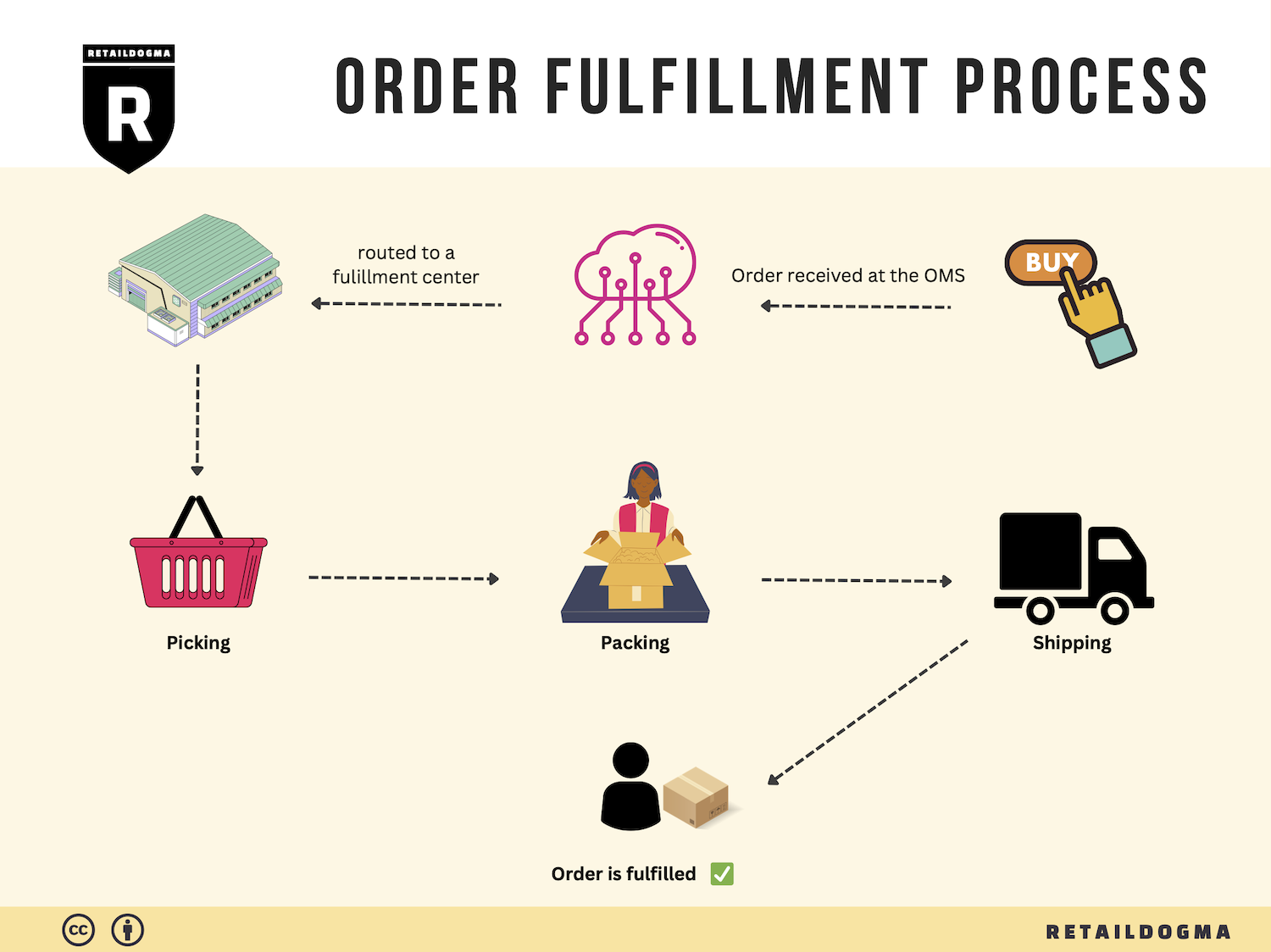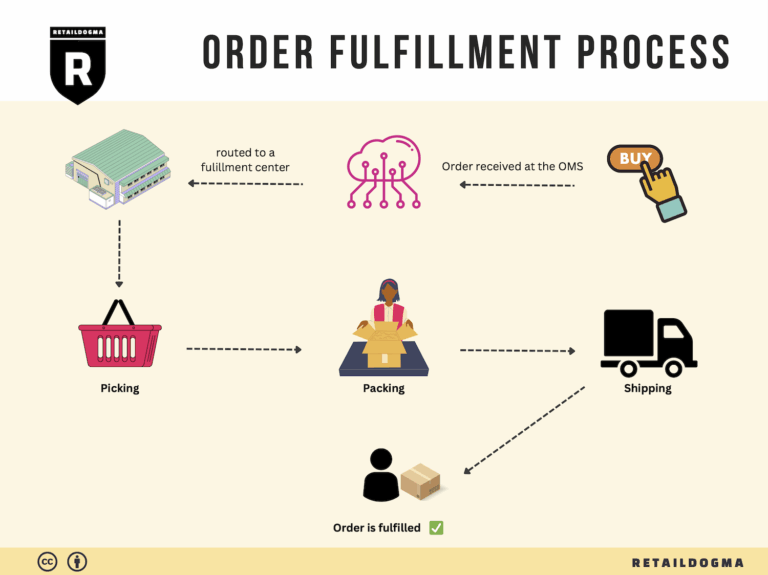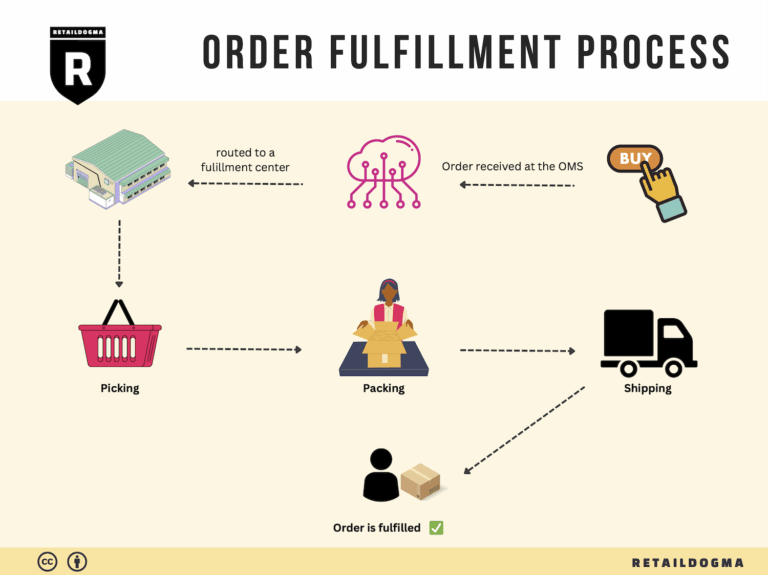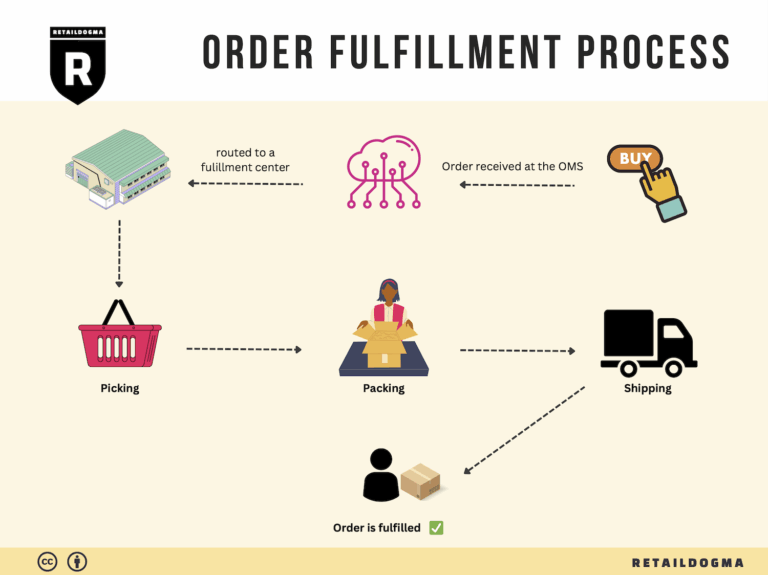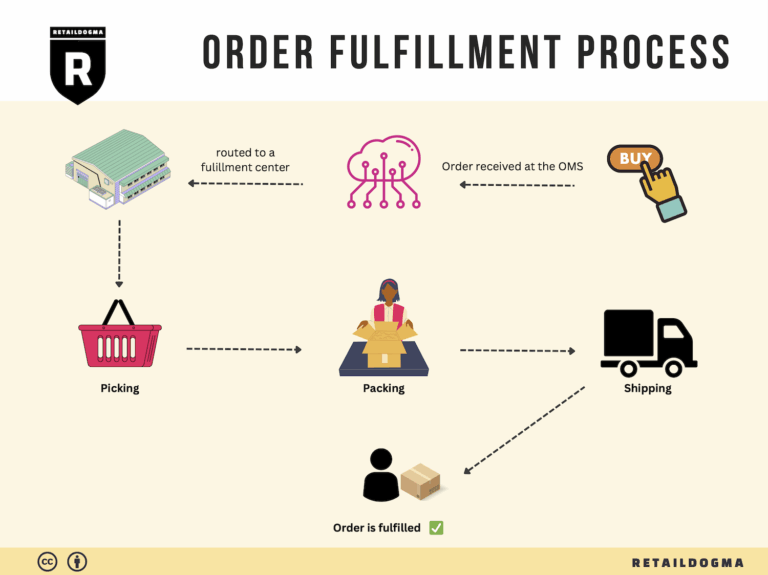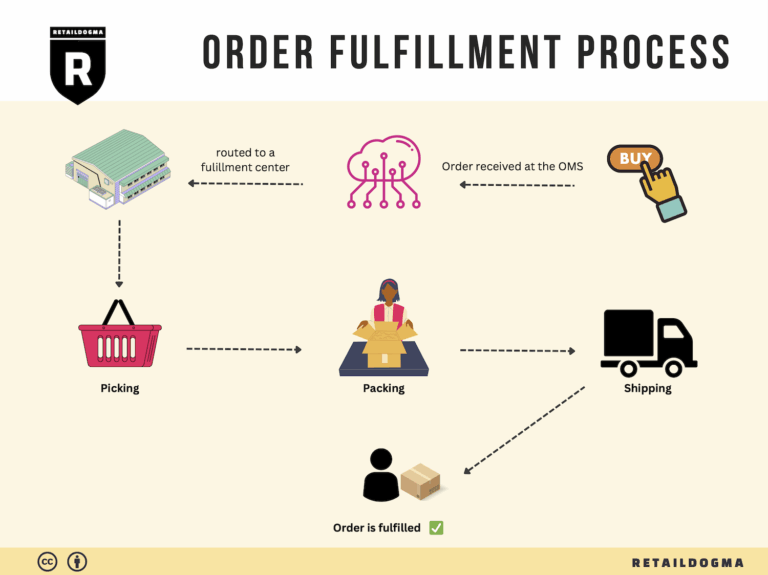Ecommerce Fulfillment Services: The Ultimate Guide (2025)
What is E-commerce Fulfillment? An Introduction for Growing Businesses
Understanding E-commerce Fulfillment: A Crucial Element for Growth
As an e-commerce business owner, you may find yourself grappling with the complexities of packing and shipping orders. The excitement of making sales can quickly turn into overwhelm as you face the daily challenges of managing logistics. Whether it’s dealing with inventory management, packaging, or ensuring timely delivery, the fulfillment process can often feel like a daunting task. This is where understanding e-commerce fulfillment becomes essential.
E-commerce fulfillment is the complete process of receiving, processing, and delivering orders to customers. It encompasses everything from inventory storage and order picking to packing and shipping. For growing businesses, effective fulfillment is not just about getting products to customers; it’s about enhancing customer satisfaction and driving repeat business. A seamless fulfillment operation can differentiate your brand in a competitive marketplace, allowing you to focus on scaling your business rather than getting bogged down in logistics.
In this guide, we will explore various fulfillment models that can fit your business needs. You’ll learn about Third-Party Logistics (3PL) providers, Fulfillment by Amazon (FBA), and other options that can help streamline your operations. Each model has its own advantages, and understanding these can help you choose the right one for your business.
We will also delve into the core services offered by fulfillment partners, including order processing, inventory management, shipping, and returns handling. Knowing what services are available will empower you to make informed decisions about which partner to select based on your specific operational needs.
Choosing the right fulfillment partner is a critical decision that can significantly impact your business’s efficiency and customer satisfaction. We will provide you with practical tips on what to look for in a fulfillment partner, including their capabilities, technology, and service levels.
Additionally, pricing is a vital aspect of the fulfillment process that can vary widely based on the services you choose and the complexity of your operations. We will break down the common pricing structures used by fulfillment providers, helping you understand what to expect and how to budget effectively.
Our goal with this guide is to empower you, the growing business owner, to make smart decisions about your logistics strategy. By understanding the nuances of e-commerce fulfillment, you can optimize your operations, enhance customer experiences, and ultimately drive growth for your business.
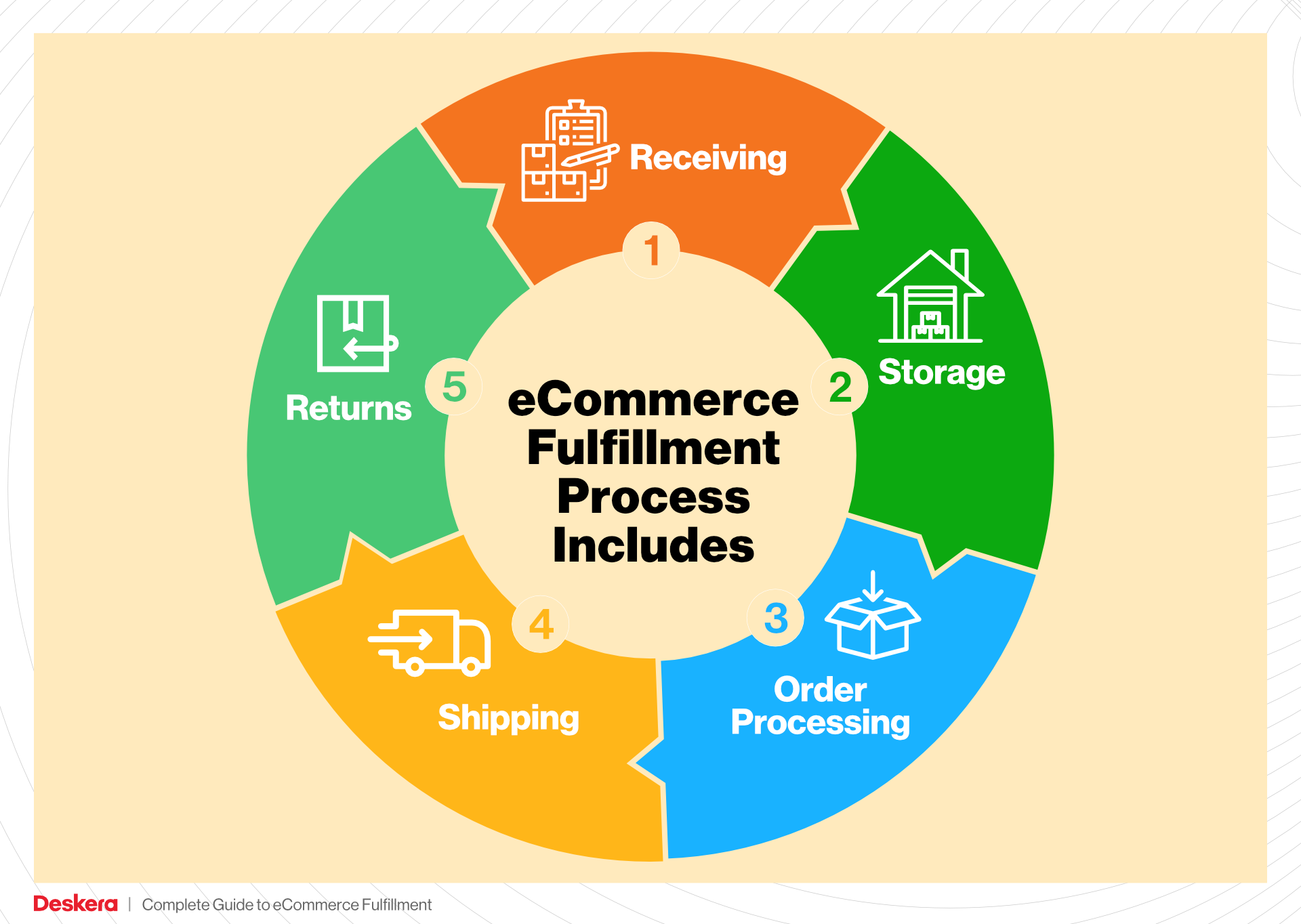
What You’ll Learn In This Guide
- What is E-commerce Fulfillment? An Introduction for Growing Businesses
- The Order Fulfillment Process: From ‘Buy’ Button to Customer’s Door
- Comparing Fulfillment Models: In-House vs. 3PL vs. Dropshipping
- A Deep Dive into Amazon FBA: Pros, Cons, and Who It’s For
- Core Services Offered by Fulfillment Centers
- How to Choose a Fulfillment Partner: A 6-Point Checklist
- Understanding Fulfillment Pricing: A Breakdown of Common Fees
- Frequently Asked Questions (FAQs) about Fulfillment
- Conclusion: Is Outsourcing Fulfillment the Right Move for Your Business?
- Important Disclaimer
The Order Fulfillment Process: From ‘Buy’ Button to Customer’s Door
1. Receiving Inventory
The order fulfillment process begins with receiving inventory, a crucial step that sets the foundation for effective logistics. When ticket fulfillment services, like Ticket Fulfillment Services LP, receive inventory (in this case, event tickets), they need to ensure that all items match the purchase orders and are in acceptable condition. This involves verifying quantities, checking for damage, and confirming that the correct items have been delivered.
Key Term: SKU (Stock Keeping Unit)
Each item should have a unique SKU, which helps in tracking and managing inventory efficiently. By scanning these SKUs upon receipt, businesses can quickly update their inventory systems, reducing the chance of discrepancies that could affect future orders.
Why It’s Important:
Accurate receiving is vital because it minimizes errors in inventory counts and ensures that the fulfillment process runs smoothly. Any mistakes at this stage can lead to stockouts or overstock situations, both of which can harm sales and customer satisfaction.
2. Warehouse Storage
Once inventory is received, the next step is warehouse storage. This phase involves organizing and storing the tickets in a manner that allows for easy access and efficient order processing. Proper storage strategies, such as categorizing tickets by event, date, or location, can significantly enhance retrieval speed.
Key Term: FIFO (First In, First Out)
Implementing a FIFO system ensures that the oldest tickets are sold first, reducing the risk of holding onto unsold inventory that may become obsolete.
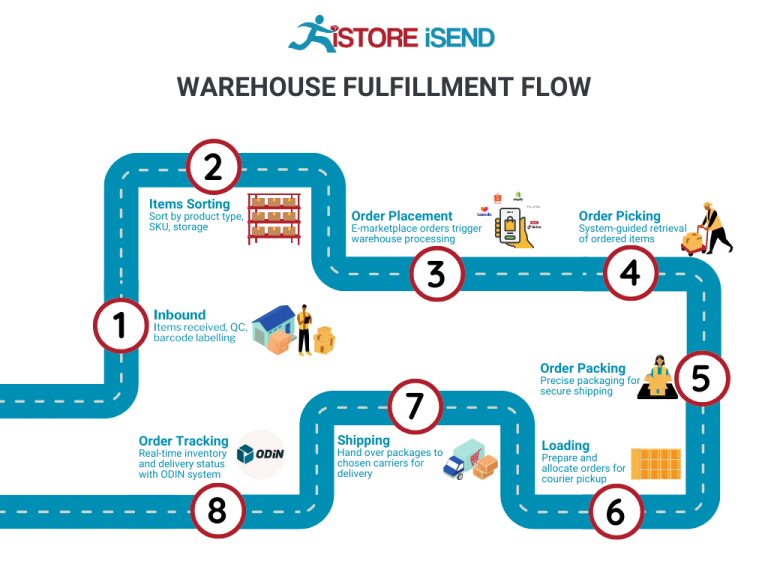
Why It’s Important:
Efficient warehouse storage optimizes space utilization and streamlines the picking process. Well-organized inventory aids in faster order fulfillment, ultimately leading to improved customer satisfaction and quicker turnaround times.
3. Order Picking
Order picking is the process of retrieving the correct tickets for customer orders. This step is crucial as it directly impacts the accuracy and speed of fulfilling orders. Businesses typically utilize pick lists, which detail the tickets needed for each order, to streamline this process.
Key Term: Pick List
A pick list serves as a guide for warehouse staff, outlining the specific tickets required for each order, including details such as SKU, event name, and quantity.
Why It’s Important:
Accurate order picking is essential to ensure that customers receive the right tickets. Errors in this stage can lead to returns, refunds, and customer dissatisfaction. A well-structured picking process can significantly reduce picking errors and enhance operational efficiency.
4. Order Packing
After the tickets have been picked, the next step is order packing. This involves securely packaging the tickets to prevent damage during transit and including any necessary documentation, such as invoices or return instructions.
Key Term: Packing Slip
A packing slip is an essential document that accompanies the order, detailing the contents of the package and serving as a receipt for the customer.

Why It’s Important:
Effective packing not only protects the product but also enhances the overall customer experience. A well-packed order gives customers confidence in the seller and can reduce the likelihood of returns due to damaged items. Moreover, including a packing slip helps in maintaining transparency and trust.
5. Shipping & Delivery
The final step in the order fulfillment process is shipping and delivery. This phase involves selecting the appropriate shipping method based on customer preferences and order requirements. Businesses must also ensure that tracking information is provided to customers for transparency.
Key Term: Last Mile Delivery
Last mile delivery refers to the final step of the shipping process where the ticket is delivered from a transportation hub to the final customer location. This stage is crucial for ensuring customer satisfaction.
Why It’s Important:
Efficient shipping and delivery are critical for maintaining customer satisfaction and loyalty. Delays or issues in this phase can lead to negative customer experiences and harm a business’s reputation. By optimizing shipping strategies and providing reliable delivery options, businesses can enhance their fulfillment processes and drive repeat sales.
In conclusion, the order fulfillment process encompasses several critical steps, each playing a significant role in the overall efficiency of e-commerce operations. By understanding and optimizing each stage—from receiving inventory to shipping and delivery—business owners can improve their logistics and enhance customer satisfaction, paving the way for scalable growth.
Comparing Fulfillment Models: In-House vs. 3PL vs. Dropshipping
Fulfillment Models Comparison
| Model | Who Handles Inventory | Best For (Business Stage) | Key Advantage | Key Disadvantage |
|---|---|---|---|---|
| In-House Fulfillment | The business itself | Established businesses with stable sales | Full control over inventory and processes | High operational costs and complexity |
| Third-Party Logistics (3PL) | External logistics provider | Growing businesses looking to scale | Flexibility and scalability | Less control over logistics and potential hidden fees |
| Dropshipping | Supplier or manufacturer | Startups and small businesses | Low overhead and minimal risk | Lower margins and reliance on suppliers |
In-House Fulfillment
In-house fulfillment involves managing all aspects of the order fulfillment process within the business itself. This model is typically adopted by established e-commerce companies that have a steady sales volume and a well-defined customer base. By handling inventory management, order processing, and shipping internally, businesses maintain complete control over their operations. This allows for tailored customer experiences, improved quality assurance, and the ability to make quick adjustments to inventory based on demand fluctuations. However, the key disadvantage of this model is the high operational costs associated with warehousing, staffing, and technology infrastructure. Additionally, the complexity of managing logistics can lead to inefficiencies if not handled properly, especially as the business scales.
Third-Party Logistics (3PL)
Third-party logistics (3PL) is a fulfillment model where businesses outsource their logistics and supply chain operations to specialized providers. This approach is ideal for growing e-commerce businesses that need to scale quickly without the burden of managing logistics themselves. 3PL providers offer a range of services, including warehousing, inventory management, and shipping, allowing businesses to focus on their core competencies such as marketing and customer engagement. The flexibility and scalability of 3PL services enable businesses to adapt to changing market demands without incurring significant upfront costs. However, relying on a third-party provider can lead to less control over the logistics process, which may impact customer service and satisfaction. Additionally, businesses must be wary of potential hidden fees and ensure that the 3PL provider aligns with their operational goals.
Dropshipping
Dropshipping is a fulfillment model where the retailer does not hold any inventory but instead relies on suppliers or manufacturers to fulfill orders directly to customers. This model is particularly appealing for startups and small businesses due to its low overhead and minimal financial risk. Entrepreneurs can launch their e-commerce stores without the need for significant upfront investment in inventory or warehousing. Since products are shipped directly from suppliers to customers, businesses can offer a wide range of products without the complexities of inventory management. However, the main drawback of dropshipping is the lower profit margins compared to other fulfillment models. Additionally, businesses are highly dependent on their suppliers for product quality, inventory availability, and shipping times, which can lead to customer dissatisfaction if not managed properly. Maintaining effective communication with suppliers is crucial to ensure a seamless customer experience.
Conclusion
Choosing the right fulfillment model is critical for e-commerce business owners seeking to scale effectively. Each model—In-House Fulfillment, Third-Party Logistics, and Dropshipping—has its unique advantages and disadvantages. Understanding these nuances will empower business leaders to make informed decisions that align with their operational goals and customer expectations. As businesses grow and evolve, they may find that a hybrid approach, combining elements of these models, offers the most flexibility and efficiency in meeting their specific needs.
A Deep Dive into Amazon FBA: Pros, Cons, and Who It’s For
What is Fulfillment by Amazon (FBA)?
Fulfillment by Amazon (FBA) is a service offered by Amazon that allows sellers to store their products in Amazon’s fulfillment centers. Amazon takes care of storage, packaging, and shipping of products directly to customers. This service provides sellers with access to Amazon’s vast logistics network, which includes Prime shipping, customer service, and returns management. By leveraging FBA, sellers can focus on scaling their business while Amazon handles the intricate logistics of order fulfillment.
How FBA Works
-
Product Listing and Inventory: Sellers create a product listing on Amazon and ship their inventory to Amazon’s fulfillment centers. Each product is tagged with a unique barcode that Amazon scans upon arrival.
-
Storage: Once the products are in Amazon’s warehouses, they are stored until an order is placed. Amazon charges storage fees based on the amount of space used.
-
Order Processing: When a customer places an order for a product, Amazon picks, packs, and ships the item on behalf of the seller. This process is automated and takes advantage of Amazon’s efficient logistics system.
-
Shipping and Delivery: Amazon handles all shipping logistics, offering various shipping options, including same-day and two-day delivery for Prime members.
-
Customer Service and Returns: Amazon manages customer inquiries and handles returns, making the process seamless for both sellers and customers.
Pros of FBA
-
Prime Eligibility: Products fulfilled by Amazon are eligible for Amazon Prime, which can significantly increase sales. Prime members often prefer to buy products with the Prime badge due to the benefits of free and fast shipping.
-
Customer Trust: Selling through FBA can enhance customer trust. Buyers feel more secure purchasing from sellers who use Amazon’s fulfillment service, given Amazon’s reputation for reliability and customer service.
-
Multi-Channel Fulfillment: FBA allows sellers to fulfill orders from other sales channels, such as their own websites or other e-commerce platforms. This flexibility can streamline operations and improve inventory management.
-
Scalability: FBA allows businesses to scale quickly without the need for additional warehousing and logistics infrastructure. Sellers can send large quantities of products to Amazon and leverage its systems to handle increased order volumes.
-
Time-Saving: FBA significantly reduces the time sellers spend on order fulfillment and customer service. This allows them to focus on marketing, product development, and other growth strategies.
Cons of FBA
-
High Fees: While FBA can increase sales, it comes at a cost. Sellers must pay storage fees and fulfillment fees, which can eat into profit margins. It’s essential to carefully calculate these costs to ensure that FBA is financially viable.
-
Strict Inventory Rules: Amazon has strict guidelines for inventory management, including limits on how much stock can be sent to fulfillment centers. Sellers need to monitor their inventory closely to avoid stockouts or excess fees.
-
Commingling Risks: In an effort to optimize storage and shipping, Amazon may commingle inventory from different sellers. This can lead to issues if a customer receives a defective or counterfeit product, potentially damaging the seller’s reputation.
-
Less Control: Using FBA means giving up a degree of control over the fulfillment process. Sellers are dependent on Amazon’s logistics and customer service, which can be problematic if issues arise.
-
Potential for Account Suspension: Sellers who violate Amazon’s policies risk having their accounts suspended, which can halt sales and affect cash flow. Understanding and adhering to Amazon’s rules is critical.
Who is FBA Best For?
FBA is particularly beneficial for:
-
Small to Medium-Sized Businesses: Sellers who may not have the resources to manage their logistics can leverage FBA to compete with larger businesses.
-
E-commerce Entrepreneurs: Those looking to scale their online sales quickly will find FBA an attractive option due to its efficiency and reach.
-
Sellers with High Sales Volume: Businesses that consistently sell high volumes can benefit from FBA’s economies of scale, helping to reduce per-unit fulfillment costs.
-
Brands Looking to Build Trust: New or lesser-known brands can enhance their credibility by using FBA, as customers often prefer purchasing from sellers who are part of the Amazon ecosystem.
-
Multi-Channel Sellers: Businesses that sell on multiple platforms can streamline their fulfillment process with FBA, enabling them to manage inventory and orders more effectively.
In conclusion, Fulfillment by Amazon offers a powerful solution for e-commerce businesses looking to simplify their logistics and scale their operations. While there are challenges, the potential benefits, particularly in terms of increased sales and customer trust, make FBA an attractive option for many sellers. Careful consideration of costs and operational requirements is essential to ensure that it aligns with a business’s overall strategy.
Core Services Offered by Fulfillment Centers
Inventory Management & Warehousing
Inventory management is a critical component of e-commerce operations, and fulfillment centers excel in this area. These centers provide businesses with comprehensive inventory tracking systems that help manage stock levels in real-time. Utilizing advanced software solutions, fulfillment centers can monitor inventory turnover rates, forecast demand, and optimize stock levels to prevent overstocking or stockouts.
The benefits of effective inventory management through fulfillment centers are multifaceted. Firstly, businesses can reduce carrying costs by maintaining optimal inventory levels. Secondly, accurate inventory tracking minimizes the risk of errors, such as shipping incorrect items or quantities, which can lead to customer dissatisfaction and increased returns. Additionally, with centralized warehousing, e-commerce businesses can streamline their supply chain, enabling quicker order fulfillment and enhancing customer satisfaction through timely deliveries.
Pick and Pack Services
Pick and pack services are essential for e-commerce operations, particularly for businesses with diverse product offerings. This process involves selecting products from the warehouse based on customer orders (picking) and then packaging them appropriately for shipment (packing). Fulfillment centers employ trained staff and sophisticated systems to ensure accuracy and efficiency in these tasks.
The primary advantage of utilizing pick and pack services is the significant reduction in order processing time. Fulfillment centers can handle large volumes of orders swiftly, allowing businesses to meet customer expectations for fast shipping. Furthermore, outsourcing these services allows e-commerce businesses to focus on core activities such as marketing and product development, rather than the logistics of order fulfillment. This leads to a more agile business model capable of scaling operations as demand fluctuates.
Kitting and Assembly
Kitting and assembly services offered by fulfillment centers involve the grouping of individual items into ready-to-ship sets or kits. This is particularly beneficial for businesses that sell products that are often bundled together, such as gift sets or promotional items. The fulfillment center assembles these kits before shipment, ensuring that they are packaged neatly and efficiently.
The benefits of kitting and assembly are substantial. For e-commerce businesses, this service can enhance the customer experience by providing ready-to-use products, saving consumers time and effort. Additionally, it can lead to increased sales through upselling opportunities, as bundled products often have higher perceived value. Moreover, by outsourcing kitting and assembly, businesses can streamline their operations and reduce labor costs associated with in-house assembly.
Returns Management (Reverse Logistics)
Returns management, often referred to as reverse logistics, is an essential service provided by fulfillment centers that can significantly impact customer satisfaction and operational efficiency. This service encompasses the processes involved in handling returns, from receiving returned items to restocking or disposing of them appropriately.
The effective management of returns is crucial for e-commerce businesses, as it directly influences customer loyalty and brand reputation. A well-structured returns process can enhance customer trust, encouraging repeat purchases. Fulfillment centers utilize technology to track returns and analyze patterns, helping businesses identify issues with specific products or processes. By streamlining the returns process, companies can reduce costs associated with handling returns and improve overall inventory management.
In summary, the core services offered by fulfillment centers, including inventory management and warehousing, pick and pack services, kitting and assembly, and returns management, are designed to enhance the efficiency and effectiveness of e-commerce operations. By leveraging these services, businesses can focus on growth and customer satisfaction while maintaining a lean and agile supply chain.
How to Choose a Fulfillment Partner: A 6-Point Checklist
Location & Warehouse Network
Importance:
The geographical location of your fulfillment partner’s warehouses can significantly impact shipping times and costs. A partner with strategically located warehouses can enable faster delivery to your customer base, thereby enhancing customer satisfaction and potentially lowering shipping expenses.
Questions to Ask:
– Where are your warehouses located, and how does this align with our target customer base?
– Do you have a network of warehouses that can cover multiple regions effectively?
– How do you manage inventory across different locations to ensure efficient fulfillment?
Technology & Integrations
Importance:
In today’s digital landscape, technology plays a crucial role in streamlining operations. A fulfillment partner with robust technology can provide real-time inventory tracking, automated order processing, and seamless integrations with your existing e-commerce platforms.
Questions to Ask:
– What technology do you use for order management, and how does it integrate with our current systems (e.g., Shopify, WooCommerce)?
– Can you provide real-time inventory updates and tracking for our orders?
– How do you ensure data security and compliance with regulations?
Specializations (e.g., Cold Storage, Oversized Items)
Importance:
Different businesses have unique fulfillment needs. If your products require specific handling, such as temperature control for perishables or special packaging for oversized items, it’s crucial to choose a partner with the necessary capabilities.
Questions to Ask:
– What specializations do you offer in terms of product handling (e.g., cold storage, fragile items)?
– Have you previously worked with businesses in our industry, and what were the outcomes?
– Can you accommodate future product lines that may require different handling?
Scalability & Capacity
Importance:
As your business grows, so will your fulfillment needs. Choosing a partner that can scale their services to match your growth trajectory is vital to avoid disruptions in service or delays in order fulfillment.
Questions to Ask:
– How do you handle fluctuations in order volume, such as during peak seasons?
– What is your current capacity for handling orders, and how quickly can you scale if our order volume increases?
– Are there any limits to the services you can provide as we grow?
Pricing and Contracts
Importance:
Understanding the pricing structure and contract terms is essential to ensure that your fulfillment partner aligns with your budget and financial goals. Transparent pricing can help you avoid unexpected fees that could impact your margins.
Questions to Ask:
– What is your pricing model (e.g., per order, per item, monthly fees)?
– Are there additional costs for services such as returns processing or storage?
– Can you provide a sample contract, and what are the terms for cancellation or changes to the agreement?
Customer Support & Reviews
Importance:
The level of customer support provided by your fulfillment partner can greatly influence your own customer experience. Timely and effective support can resolve issues quickly and maintain operational efficiency.
Questions to Ask:
– What customer support options do you offer (e.g., phone, email, chat), and what are your response times?
– Can you provide references or reviews from other clients in our industry?
– How do you handle complaints or issues that arise during the fulfillment process?
Conclusion
Choosing the right fulfillment partner is a critical decision that can impact your business’s operational efficiency and customer satisfaction. By following this checklist and asking the right questions, you can ensure that you select a partner who not only meets your current needs but also supports your growth and success in the future.
Understanding Fulfillment Pricing: A Breakdown of Common Fees
Initial Setup Fees
Initial setup fees are one-time charges that businesses incur when they first establish a relationship with a ticket fulfillment service. This fee typically covers the costs associated with onboarding, which may include integrating software systems, customizing the fulfillment process to align with your specific business needs, and initial training for your team on how to utilize the fulfillment platform effectively.
The calculation of initial setup fees can vary significantly between providers. Factors influencing these fees include the complexity of your inventory management needs, the level of customization required, and the provider’s pricing structure. Generally, you can expect to pay anywhere from a few hundred to several thousand dollars, depending on the scale of your operations and the specific services being implemented.
Receiving Fees
Receiving fees are charged when the fulfillment center accepts and processes incoming inventory. This fee typically covers the labor and resources required to unload shipments, inspect items for quality, and enter them into the inventory management system. For ticket fulfillment services, this might also include the verification of ticket authenticity and integration into the sales platform.
These fees are usually calculated based on the volume of tickets received or the time spent processing incoming shipments. Some fulfillment providers may charge a flat fee per shipment, while others might base their fees on the number of items or pallets received. Understanding your anticipated volume will help you estimate these costs more accurately.
Storage Fees (per pallet/bin)
Storage fees are incurred for the space your inventory occupies within the fulfillment center. For ticket fulfillment services, this could refer to the physical space allocated for storing tickets or any materials related to your ticket sales (like marketing materials).
These fees can be charged on a per-pallet or per-bin basis, depending on how your fulfillment provider organizes their storage. Rates can vary widely based on location, the size of your inventory, and how long the items will be stored. It’s essential to assess your inventory turnover rate to minimize storage costs, as prolonged storage can lead to increased fees.
Pick & Pack Fees (per item/order)
Pick and pack fees are charged for the process of selecting items from inventory and preparing them for shipment. In the context of ticket fulfillment, this involves retrieving the correct tickets from the storage area, packaging them securely, and labeling them for delivery.
These fees are typically calculated on a per-item or per-order basis. For instance, a fulfillment service might charge a fixed fee for picking and packing an order, plus an additional fee for each item included in that order. Understanding your average order size can help you forecast these costs effectively. Keep in mind that efficiency in your order processing can significantly reduce these fees over time.
Shipping Fees
Shipping fees are among the most variable costs in the fulfillment process. These fees cover the transportation of tickets from the fulfillment center to the customer. Factors influencing shipping fees include the weight and dimensions of the package, the shipping method chosen (e.g., standard, expedited), and the destination.
Shipping costs can be calculated using various methods, such as flat-rate shipping, weight-based shipping, or distance-based shipping. It’s crucial to work with your fulfillment provider to understand their shipping options and negotiate rates with carriers to find the most cost-effective solution for your business.
Tips for Getting an Accurate Quote
-
Be Transparent About Your Needs: Provide your fulfillment provider with detailed information about your business model, expected order volume, and specific requirements. This transparency helps them tailor their quote to your needs.
-
Ask for a Breakdown: Request a detailed breakdown of all potential fees associated with your fulfillment services. Understanding each component will help you assess the overall cost more effectively.
-
Consider Seasonal Variations: If your business experiences seasonal fluctuations in order volume, discuss how this might impact pricing and whether the fulfillment provider can accommodate these changes without significant additional costs.
-
Negotiate Terms: Don’t hesitate to negotiate terms and fees. Many fulfillment providers are willing to offer discounts for long-term contracts or higher order volumes.
-
Request Sample Quotes: If possible, request sample quotes based on different scenarios (e.g., varying order sizes or frequencies). This approach will give you a better understanding of potential costs under different conditions.
By taking the time to understand these common fees and how they are calculated, you can better prepare your e-commerce business for the financial aspects of scaling your ticket fulfillment operations.
Frequently Asked Questions (FAQs) about Fulfillment
1. What is Ticket Fulfillment Services LP?
Ticket Fulfillment Services LP (TFS) is a business-to-business service provider that specializes in order processing for companies that operate websites offering tickets for resale. They handle tasks such as mailing tickets, processing payments, and providing customer service on behalf of their clients.
2. How does ticket fulfillment work?
Ticket fulfillment involves receiving ticket orders from customers, processing those orders, and then delivering the tickets to the customers. TFS manages this entire process for its clients, ensuring timely delivery and customer satisfaction while maintaining the confidentiality of the ticket resale operation.
3. What services does Ticket Fulfillment Services LP offer?
TFS provides a range of services including order processing, customer service, payment processing, and ticket delivery. They do not engage in the resale of tickets or operate a secondary ticket marketplace, focusing solely on fulfillment for their clients.
4. How much do ticket fulfillment services cost?
Costs for ticket fulfillment services can vary widely based on the volume of tickets processed, the complexity of services required, and specific client needs. It’s advisable for businesses to request quotes from TFS or similar providers to understand the pricing structure tailored to their operations.
5. What is the difference between a warehouse and a fulfillment center?
A warehouse is primarily a storage space for goods, focusing on inventory management. In contrast, a fulfillment center is designed to handle the entire order process, including picking, packing, shipping, and returns management. Fulfillment centers typically have more advanced technology and systems in place to streamline these operations.
6. What is a 3PL (Third-Party Logistics)?
A 3PL is a service provider that manages logistics and supply chain functions on behalf of another company. This can include transportation, warehousing, inventory management, and order fulfillment. Ticket Fulfillment Services LP acts as a 3PL for businesses that sell tickets online, managing the logistics of ticket handling.
7. What should I consider when choosing a ticket fulfillment service?
When selecting a ticket fulfillment service, consider factors such as reliability, customer service quality, technological capabilities, pricing, and the provider’s experience in the ticketing industry. Reading reviews and assessing their track record with other clients can also provide valuable insights.
8. How can I ensure timely ticket delivery?
To ensure timely ticket delivery, establish clear communication with your fulfillment provider regarding timelines and expectations. Utilize tracking systems to monitor the status of ticket shipments and ensure that customer information is accurate for seamless processing.
9. What are common challenges with ticket fulfillment?
Common challenges in ticket fulfillment include managing high demand during peak seasons, ensuring accurate inventory levels, handling customer service inquiries efficiently, and resolving delivery issues. Partnering with a reputable fulfillment service can help mitigate these challenges through experienced management and technology.
10. How can ticket fulfillment services improve customer satisfaction?
Ticket fulfillment services can enhance customer satisfaction by ensuring quick processing and delivery of tickets, providing excellent customer service for inquiries and issues, and maintaining clear communication throughout the order process. A smooth fulfillment experience can lead to repeat business and positive reviews for your brand.
Conclusion: Is Outsourcing Fulfillment the Right Move for Your Business?
Evaluating the Benefits of Outsourcing Fulfillment
As e-commerce continues to evolve, the operational demands on businesses grow increasingly complex. Outsourcing your fulfillment process can be a strategic move that brings numerous benefits, including time savings, scalability, and access to specialized expertise. By leveraging a fulfillment service, you can redirect focus from logistical challenges to growth-oriented strategies, allowing your team to concentrate on core business functions such as marketing and product development.
One of the primary advantages of outsourcing fulfillment is the significant time savings. Handling logistics in-house often involves intricate processes—from inventory management to shipping and customer service. A dedicated fulfillment partner can streamline these operations, ensuring that orders are processed swiftly and accurately. This not only enhances customer satisfaction but also frees up valuable resources within your organization.
Scalability is another crucial benefit. As your business grows, so do your fulfillment needs. A reliable fulfillment partner can easily scale operations to match your sales volume, accommodating peak seasons without the need for substantial investments in infrastructure or personnel. This flexibility is vital for maintaining service quality and meeting customer expectations during high-demand periods.
However, the success of outsourcing fulfillment hinges on selecting the right partner. It’s essential to conduct thorough due diligence—assessing their track record, customer reviews, and the range of services offered. A trustworthy partner will not only meet your current needs but also support your long-term growth ambitions.
Take Action Now
To determine if outsourcing fulfillment is the right step for your business, conduct an audit of your current shipping and logistics processes. Identify bottlenecks, inefficiencies, and areas for improvement. This assessment will provide clarity on whether a fulfillment service can enhance your operations and help you scale effectively. Start exploring potential partners today to position your business for sustained growth in an ever-competitive e-commerce landscape.
Important Disclaimer
⚠️ Important Disclaimer
The information in this guide is for educational purposes. Fulfillment services, pricing, and platform features change frequently. Always conduct your own due diligence and consult with providers directly before making business decisions.
